In-Stream Marine Litter Collection Device Location Determination Using Bayesian Network
Abstract
:1. Introduction
- This is the first study to methodologically identify and prioritize in-stream litter collection device installation sites.
- A BN approach is proposed to determine suitable in-stream litter collection device installation sites based on four criteria and fifteen sub-criteria identified in this study.
- Litter collection device locations across the Northern U.S. Gulf Coast have been used to validate the proposed approach.
2. Problem Description and Methodological Framework
2.1. Tested In-Stream Litter Collection Device—Litter Gitter
2.2. Bayesian Network (BN)
2.3. Conjoint Criteria Utilized for Assessing Litter Gitter Site Selection
2.3.1. Stream Characteristic
- Flow Rate Reduction: The LG should be placed downstream of a drop. A drop in power usually occurs when a stream straightens out, is downstream of a significant elevation change (i.e., a waterfall), or widens out. This will allow the water to flow smoothly and booms to sit correctly in the water.
- Bank Steepness: When banks are too steep, the booms attached to the LG do not lay correctly and can cause gaps that allow trash to bypass the trap. This gap occurs near the edge of the bank.
- Bank Composition: The preferred method for securing an LG is to use a tree on either side of the stream. If a tree is not available, metal t-stakes could be used.
- Linear: Traps should be placed in the straightest portion of the stream. Putting the trap in a turn/curve could cause the water to flow nonlinearly and allow trash to accumulate on the sides of the LG, leading to escape.
- Navigability: This sub-criterion refers to navigable waterways. These waterways are used for ship movement. Hence, navigable waterways are not appropriate for LG. Navigable waters that are found in the U.S. refer to waters that are subject to tidal flow, and may be used, are reported as used in the past, or may in the future be used for transport that is either interstate or foreign commerce [37].
- Creek Width: Streams between 20 and 40 ft are best suited for LG. Larger streams tend to have high flow capacity, which puts a strain on the boom system used to anchor the LG. Additionally, larger streams can carry natural debris items such as logs or trees. These large debris items can put more tension on the boom system, causing them to break free from the LG, thus causing the trap to malfunction.
- Hydrologic Flashness: Flashness refers to the frequency with which rapid, short-term changes in streamflow occur, especially during events where there is runoff and significant rain. An ideal LG placement would be in a stream that does not have significant flashes (10 ft or less). Sudden changes in water flow can cause extra tension to be placed on the anchor points for the LG.
2.3.2. Upstream Characteristics
- Impervious Surfaces: Can cause runoff, which can carry trash into stream systems. Ideally, the LG could be placed downstream of an area that will have high impervious surfaces. Examples include placing the trap downstream of a shopping center rather than upstream before the shopping center. Successful sites for LG may be placed within 0.25 miles of high-intensity developed areas.
- Population Density: Places with high population density are likely to generate more trash simply because more people are there. Ideally, the LG will be located downstream of an area with high population density.
- Major Road Crossings: A considerable amount of littering occurs around major road crossings. Ideally, the LG should be placed downstream of the road crossings to collect the litter coming from these road crossings.
2.3.3. Permissions and Permitting
2.3.4. Hazards
2.4. The Bayesian Network (BN) Methodological Framework
- Problem definition and systematic study: Systematically identifies the necessary criteria and sub-criteria required to site an LG for collecting marine litter in a coastal area. Professional input, accessible literature, and elementary LG installation procedures, as instructed by the Environmental Protection Agency (EPA), the U.S. Army Corps of Engineers (USACE), and the National Oceanic Atmospheric Administration (NOAA) [3,4], were utilized to create the criteria and sub-criteria. Overall, four criteria and fifteen sub-criteria are identified to evaluate a possible site for installing the LG (see Figure 3).
- The preliminary stage: Includes collecting data, formulating, and modeling stages. A suitable link between the criteria and sub-criteria is constructed. Related data are gathered to build the BN model with the information collected via the first stage, and a BN model is constructed for each potential site.
- Evaluating stage: Used to check the reliability and validity of the LG project. The result of the BN will undergo sensitivity analyses during the evaluating stage. If authenticated, the analyst will select the best LG site(s); if not, the first stage will be revised, and the criteria/sub-criteria selection and data collection processes will be reevaluated. The process will continue until each site is validated correctly via sensitivity analysis.
3. Floating Litter Case Study Solution
3.1. BN Model for Evaluating Candidate Litter Gitter Sites
3.1.1. Modeling of Stream Characteristic
3.1.2. Modeling of Upstream Characteristics
3.1.3. Modeling of Permissions Approval
3.1.4. Modeling of Hazards Criteria
3.2. Probability of Site Selection
3.3. Sensitivity Analysis
4. Conclusions
Author Contributions
Funding
Institutional Review Board Statement
Informed Consent Statement
Data Availability Statement
Conflicts of Interest
Appendix A

References
- Tiseo, I.; Global Waste Generation—Statistics & Facts. Statista. Available online: https://www.statista.com/topics/4983/waste-generation-worldwide/#dossierKeyfigures (accessed on 5 February 2022).
- Dias, B. Marine Debris: Understanding, Preventing, and Mitigating the Significant Adverse Impacts on Marine and Coastal Biodiversity; CBD Technical Series No.83; Secretariat of the Convention on Biological Diversity: Montreal, QC, Canada, 2016; 78p. [Google Scholar]
- Bergmann, M.; Tekman, M.B.; Gutow, L. Sea change for plastic pollution. Nature 2017, 544, 297. [Google Scholar] [CrossRef] [PubMed] [Green Version]
- Beaumont, N.J.; Aanesen, M.; Austen, M.C.; Börger, T.; Clark, J.R.; Cole, M.; Hooper, T.; Lindeque, P.K.; Pascoe, C.; Wyles, K.J. Global ecological, social and economic impacts of marine plastic. Mar. Pollut. Bull. 2019, 142, 189–195. [Google Scholar] [CrossRef] [PubMed]
- United Nations. ‘Turn the Tide on Plastic’ Urges UN, as Microplastics in the Seas Now Outnumber Stars in Our Galaxy. 2017. Available online: https://news.un.org/en/story/2017/02/552052-turn-tide-plastic-urges-un-microplastics-seas-now-outnumber-stars-our-galaxy (accessed on 15 September 2021).
- Jang, Y.C.; Hong, S.; Lee, J.; Lee, M.J.; Shim, W.J. Estimation of lost tourism revenue in Geoje Island from the 2011 marine debris pollution event in South Korea. Mar. Pollut. Bull. 2014, 81, 49–54. [Google Scholar] [CrossRef] [PubMed]
- Jambeck, J.R.; Geyer, R.; Wilcox, C.; Siegler, T.R.; Perryman, M.; Andrady, A.; Narayan, R.; Law, K.L. Plastic waste inputs from land into the ocean. Science 2015, 347, 768–771. [Google Scholar] [CrossRef] [PubMed]
- Sheavly, S.B.; Register, K.M. Marine debris & plastics: Environmental concerns, sources, impacts and solutions. J. Polym. Environ. 2007, 15, 301–305. [Google Scholar]
- Weiss, K.R. The Pileup of Plastic Debris is More than Ugly Ocean Litter. Knowable Magazine, 12 June 2017. [Google Scholar] [CrossRef]
- Sheavly, S.B. National Marine Debris Monitoring Program. Final Program Report, Data Analysis and Summary. Prepared for US Environmental Protection Agency by Ocean Conservancy, Grant, (X830534), 01–02; Ocean Conservancy: Washington, DC, USA, 2007. [Google Scholar]
- Laist, D.W. Impacts of marine debris: Entanglement of marine life in marine debris including a comprehensive list of species with entanglement and ingestion records. In Marine Debris; Springer: New York, NY, USA, 1997; pp. 99–139. [Google Scholar]
- Gregory, M.R.; Ryan, P.G. Pelagic plastics and other seaborne persistent synthetic debris: A review of Southern Hemisphere perspectives. In Marine Debris; Springer: New York, NY, USA, 1997; pp. 49–66. [Google Scholar] [CrossRef]
- Gall, S.C.; Thompson, R.C. The impact of debris on marine life. Mar. Pollut. Bull. 2015, 92, 170–179. [Google Scholar] [CrossRef]
- Eriksen, M.; Lebreton, L.C.M.; Carson, H.S.; Thiel, M.; Moore, C.J.; Borerro, J.C.; Galgani, F.; Ryan, P.G.; Reisser, J. Plastic Pollution in the World’s Oceans: More than 5 Trillion Plastic Pieces Weighing over 250,000 Tons Afloat at Sea. PLoS ONE 2014, 9, e111913. [Google Scholar] [CrossRef] [Green Version]
- Duan, G.; Aghalari, A.; Chen, L.; Marufuzzaman, M.; Ma, J. Vessel routing optimization for floating macro-marine debris collection in the ocean considering dynamic velocity and direction. Transp. Res. Part E Logist. Transp. Rev. 2021, 152, 102414. [Google Scholar] [CrossRef]
- Sartain, M.; James, J.; Rodolfich, A.; Chenier, K.; Sparks, E.; Baker, B. Mississippi Coastal Cleanup Program Summary; Mississippi State University Extension: Mississippi State, MS, USA, 2021. [Google Scholar]
- Petrolia, D.R.; Penn, J.; Quainoo, R.; Caffey, R.H.; Fannin, J.M. Know Thy Beach: Values of Beach Condition Information. Mar. Resour. Econ. 2019, 34, 331–359. [Google Scholar] [CrossRef]
- Duan, G.; Fan, T.; Chen, X.; Chen, L.; Ma, J. A Hybrid Algorithm on the Vessel Routing Optimization for Marine Debris Collection. Expert Syst. Appl. 2021, 182, 115198. [Google Scholar] [CrossRef]
- Duan, G.; Nur, F.; Alizadeh, M.; Chen, L.; Marufuzzaman, M.; Ma, J. Vessel routing and optimization for marine debris collection with consideration of carbon cap. J. Clean. Prod. 2020, 263, 121399. [Google Scholar] [CrossRef]
- Duan, G.; Fan, T.; Chen, L.; Ma, J. Floating marine debris mitigation vy vessel routing modeling and optimization considering carbon emission and travel time. Transp. Res. Part C Emerg. Technol. 2021, 133, 103449. [Google Scholar] [CrossRef]
- Awasthi, A.; Chauhan, S.S.; Omrani, H. Application of fuzzy TOPSIS in evaluating sustainable transportation systems. Expert Syst. Appl. 2011, 38, 12270–12280. [Google Scholar] [CrossRef]
- Park, K.; Kremer, G.E.O.; Ma, J. A regional information-based multi-attribute and multi-objective decision-making approach for sustainable supplier selection and order allocation. J. Clean. Prod. 2018, 187, 590–604. [Google Scholar] [CrossRef] [Green Version]
- Awasthi, A.; Omrani, H. A hybrid approach based on AHP and belief theory for evaluating sustainable transportation solutions. Int. J. Glob. Environ. Issues 2009, 9, 212–226. [Google Scholar] [CrossRef]
- Zhang, H.; Peng, Y.; Tian, G.; Wang, D.; Xie, P. Green material selection for sustainability: A hybrid MCDM approach. PLoS ONE 2017, 12, e0177578. [Google Scholar]
- Karam, S.; Nagahi, M.; Dayarathna, V.L.; Ma, J.; Jaradat, R.; Hamilton, M. Integrating systems thinking skills with multi-criteria decision -making technology to recruit employee candidates. Expert Syst. Appl. 2020, 160, 113585. [Google Scholar]
- Ma, J.; Harstvedt, J.D.; Jaradat, R.; Smith, B. Sustainability driven multi-criteria project portfolio selection under uncertain decision-making environment. Comput. Ind. Eng. 2020, 140, 106236. [Google Scholar]
- Govindan, K.; Kannan, D.; Shankar, M. Evaluation of green manufacturing practices using a hybrid MCDM model combining DANP with PROMETHEE. Int. J. Prod. Res. 2015, 53, 6344–6371. [Google Scholar] [CrossRef]
- Hwang, C.L.; Yoon, K. Methods for multiple attribute decision making. In Multiple Attribute Decision Making; Springer: Berlin/Heidelberg, Germany, 1981; pp. 58–191. [Google Scholar]
- Hosseini, S.; Sarder, M.D. Development of a Bayesian network model for optimal site selection of electric vehicle charging station. Int. J. Electr. Power Energy Syst. 2019, 105, 110–122. [Google Scholar] [CrossRef]
- Pan, Y.; Zhang, L.; Koh, J.; Deng, Y. An adaptive decision making method with copula Bayesian network for location selection. Inf. Sci. 2021, 544, 56–77. [Google Scholar] [CrossRef]
- Penman, T.D.; Cirulis, B.; Marcot, B.G. Bayesian decision network modeling for environmental risk management: A wildfire case study. J. Environ. Manag. 2020, 270, 110735. [Google Scholar] [CrossRef]
- Chen, S.; Wang, C. Incorporating a Bayesian network into two-stage stochastic programming for blood bank location-inventory problem in case of disasters. Discret. Dyn. Nat. Soc. 2019, 2019, 7214907. [Google Scholar] [CrossRef]
- Jing, L.; Tan, B.; Jiang, S.; Ma, J. Additive manufacturing industrial adaptability analysis using fuzzy Bayesian Network. Comput. Ind. Eng. 2021, 155, 107216. [Google Scholar]
- Amrani, S.E.; Hossain, N.U.I.; Karam, S.; Jaradat, R.; Nur, F.; Hamilton, M.A.; Ma, J. Modelling and assessing sustainability of a supply chain network leveraging multi Echelon Bayesian Network. J. Clean. Prod. 2021, 302, 126855. [Google Scholar]
- Fenton, N.; Neil, M. Risk Assessment and Decision Analysis with Bayesian Networks; CRC Press: Boca Raton, FL, USA, 2018. [Google Scholar]
- Hosseini, S.; Barker, K. A Bayesian network model for resilience-based supplier selection. Int. J. Prod. Econ. 2016, 180, 68–87. [Google Scholar]
- Baughman, J.F. Balancing Commece, History, and Geography: Defining the Navigable Waters of the United States. Mich. Law Rev. 1991, 90, 1028. [Google Scholar] [CrossRef] [Green Version]
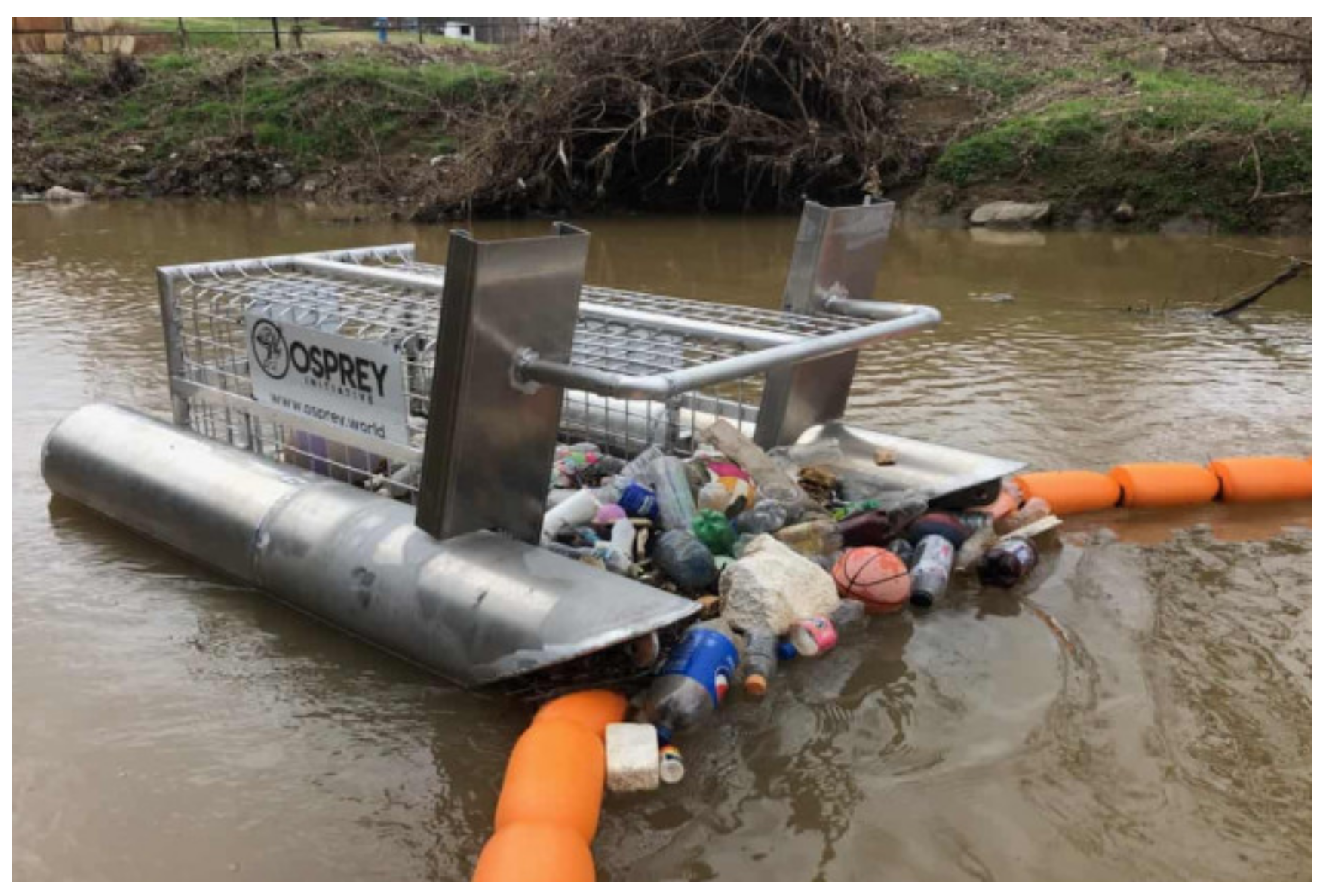
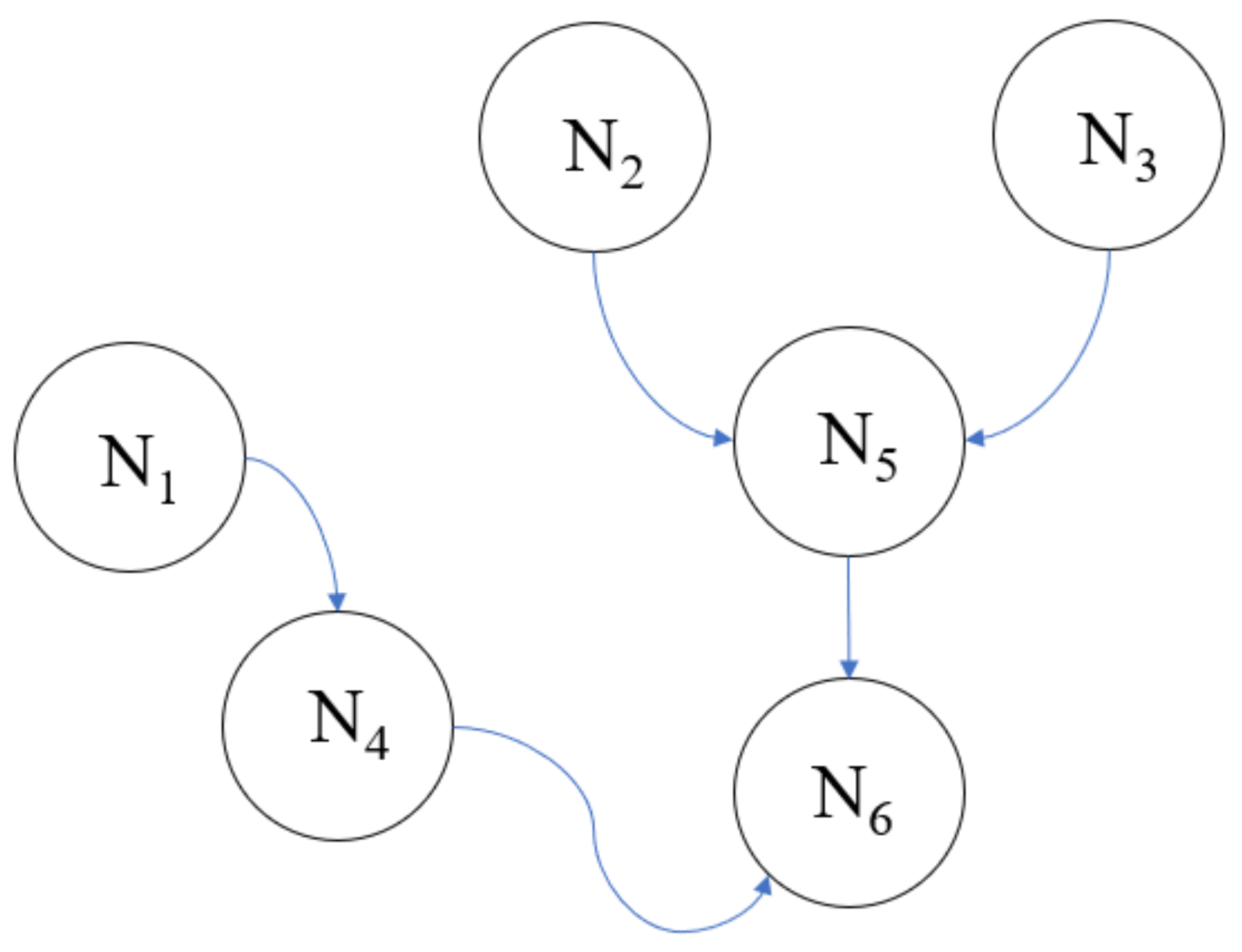
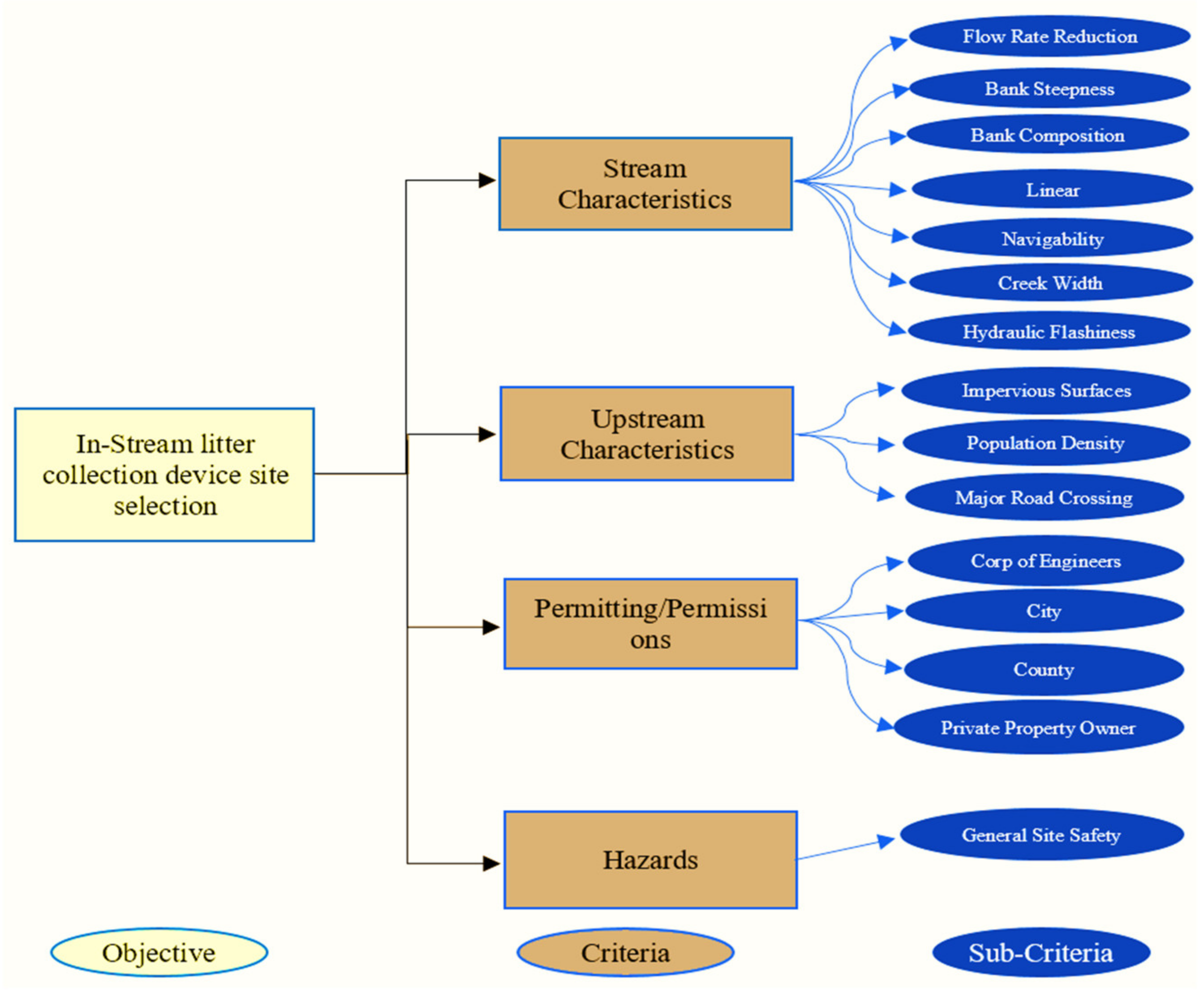




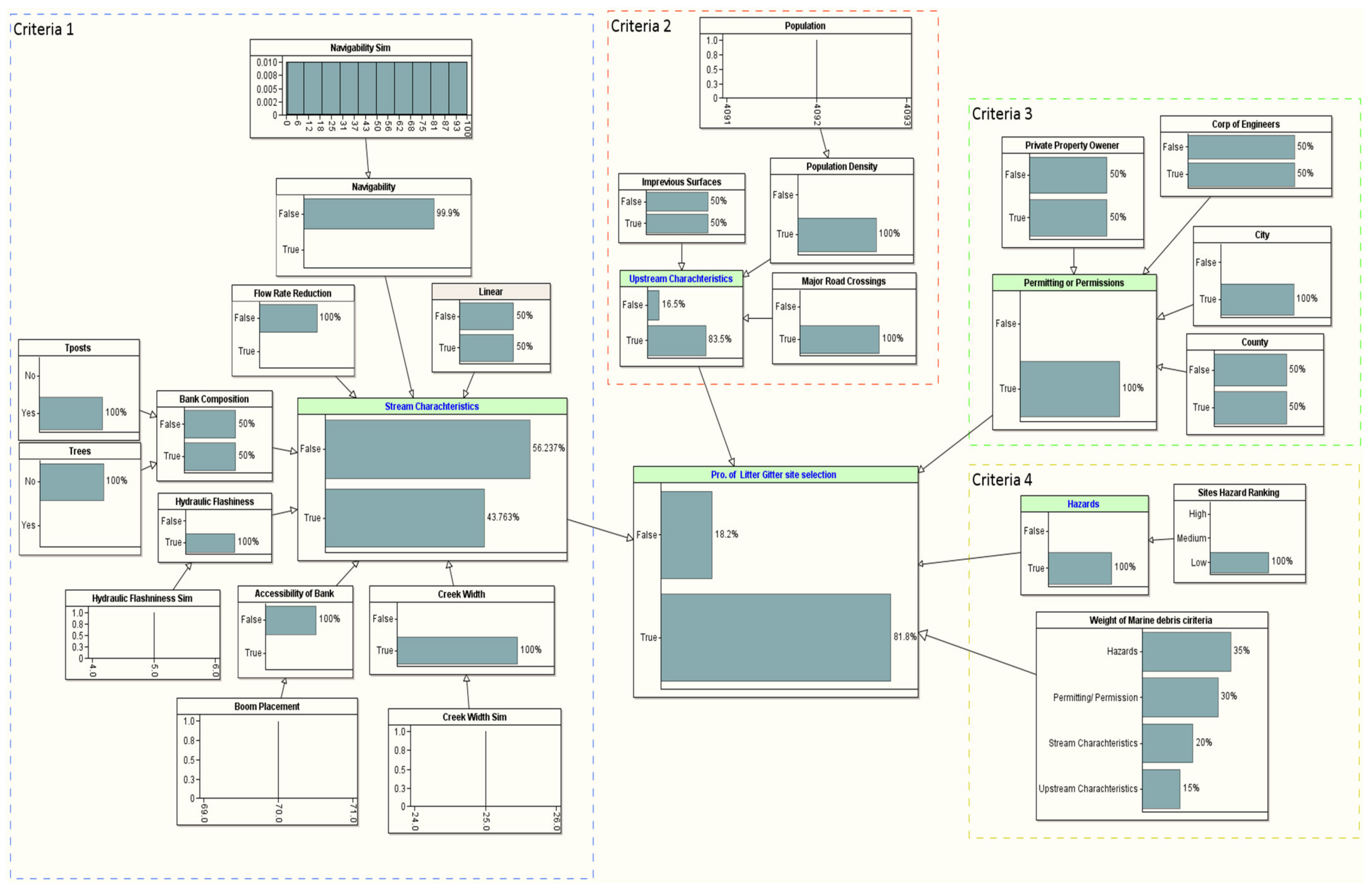


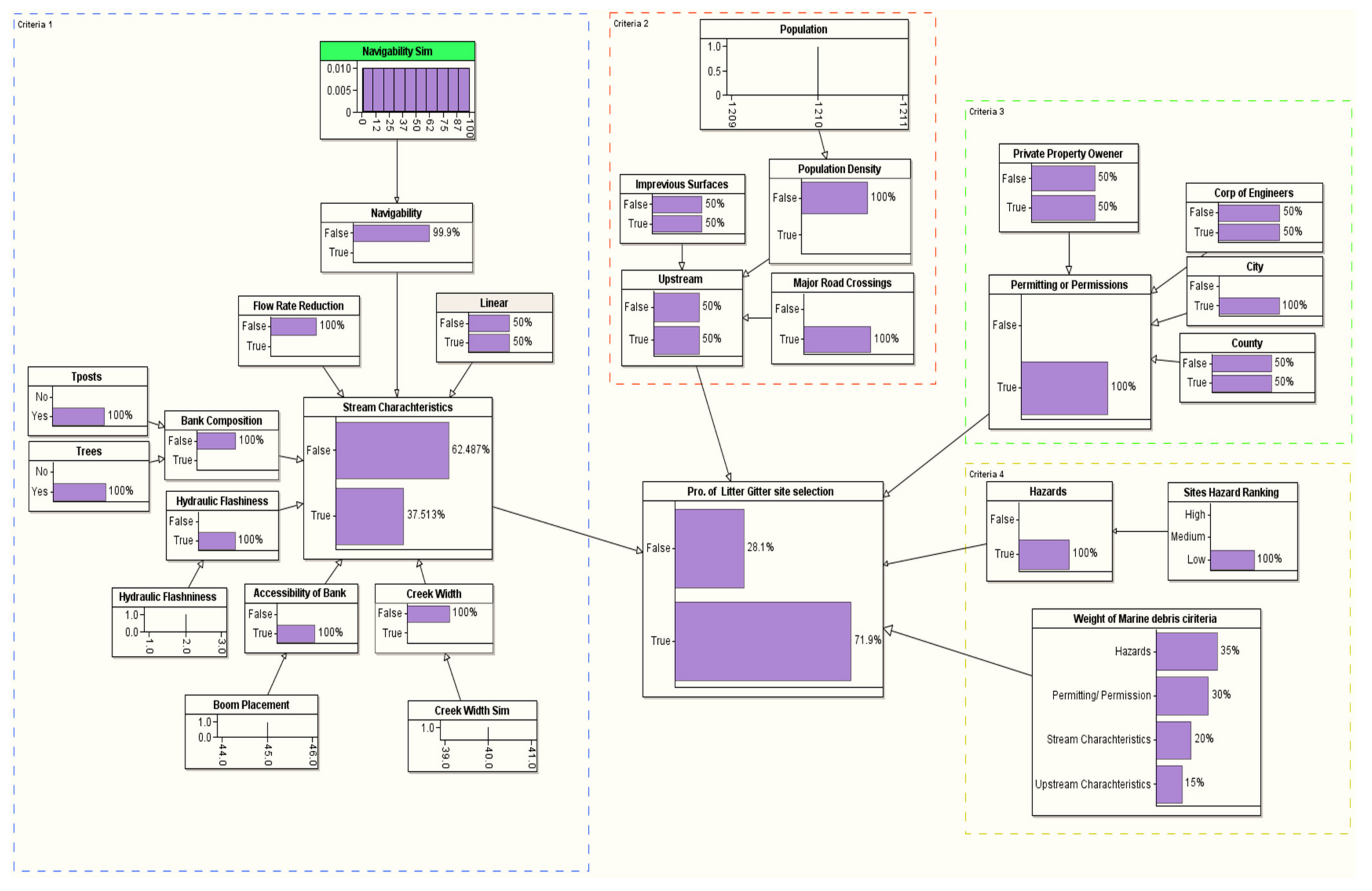
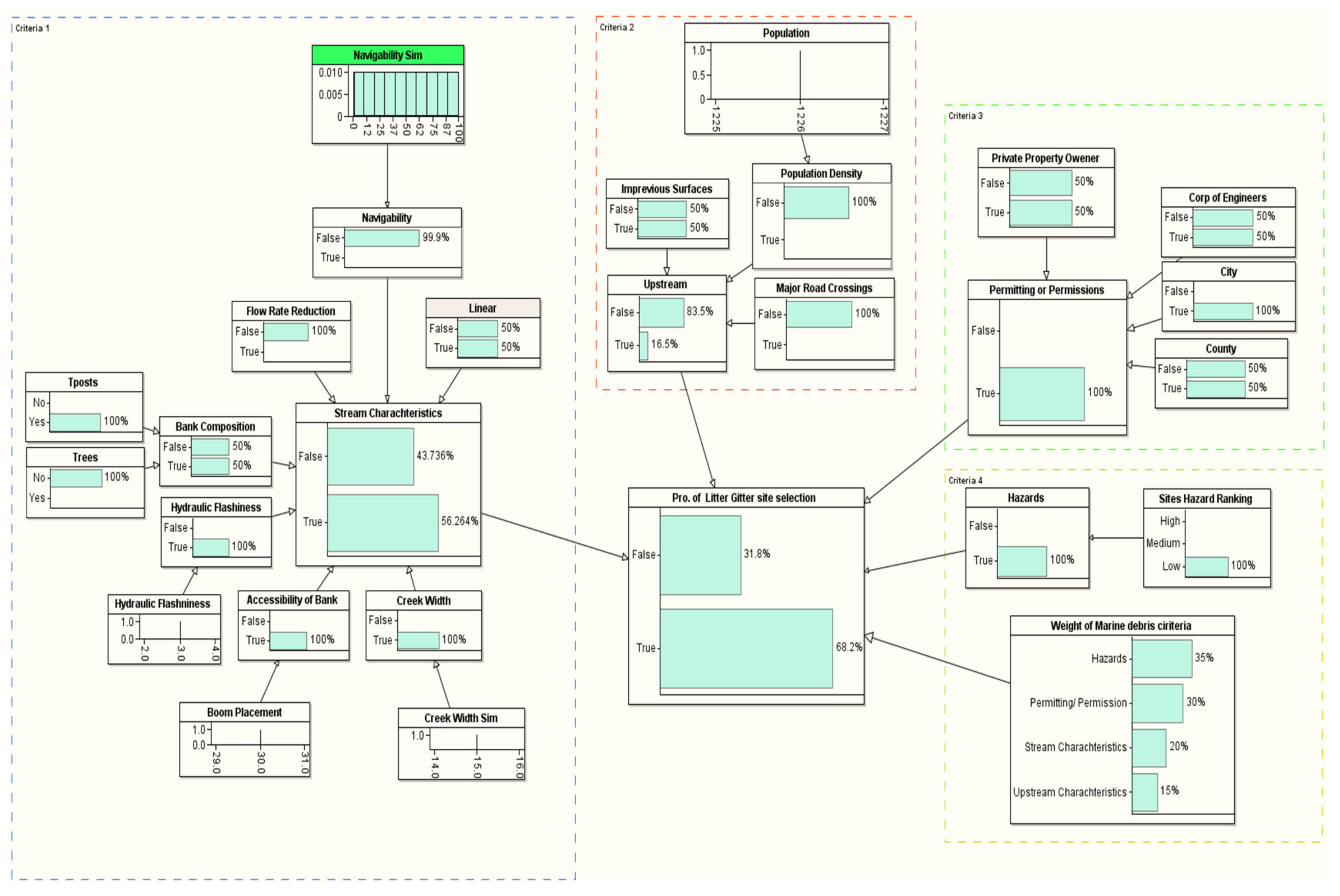
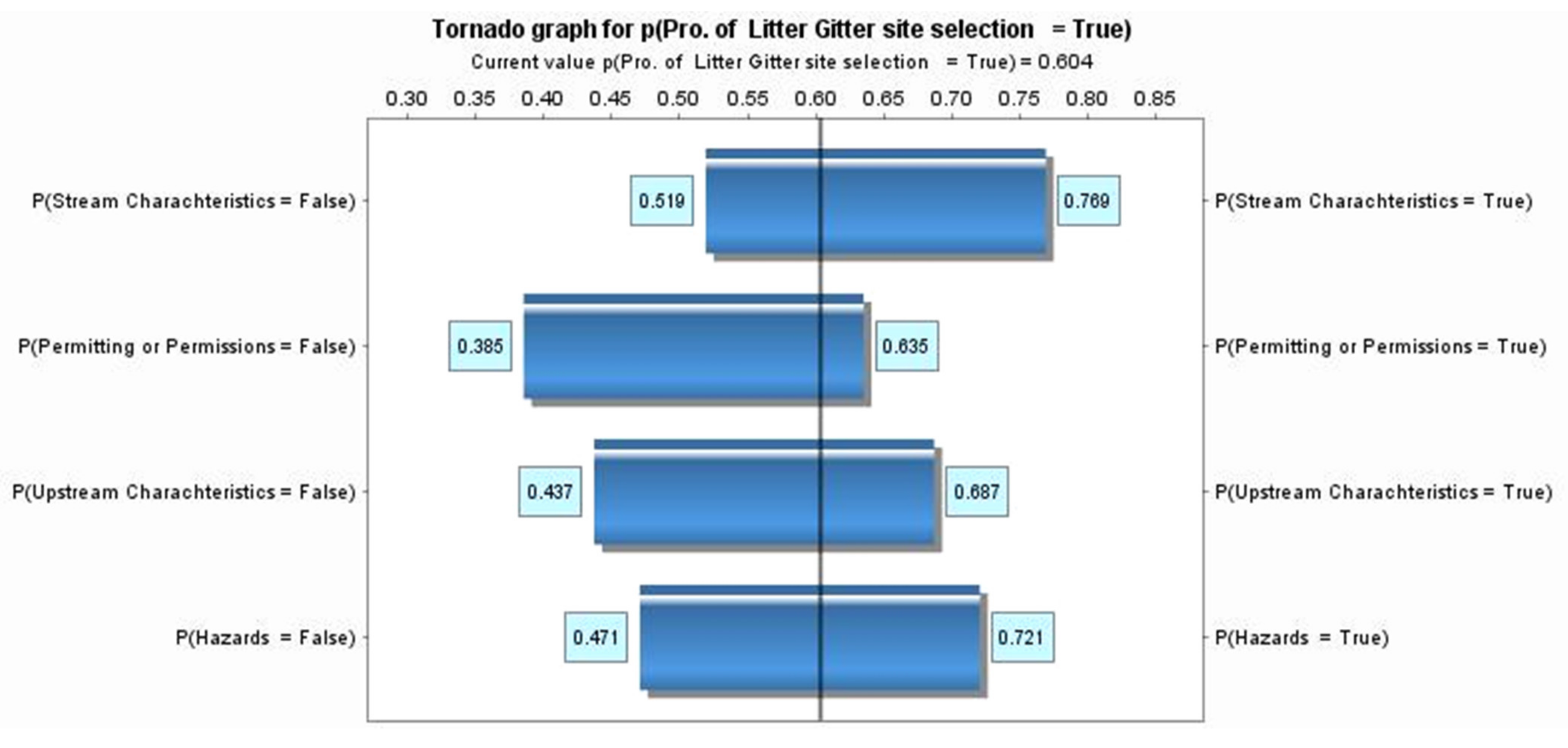

| Site | City | State | Location Name | LG Location | |
|---|---|---|---|---|---|
| Latitude | Longitude | ||||
| 1 | Mobile | AL | DR-Eslava Sage | 30.67321 | −88.11316 |
| 2 | Mobile | AL | 3MC-1MC Lawrence | 30.70263 | −88.05416 |
| 3 | Daphne | AL 1 | DO-D’Olive Creek US98 | 30.65274 | −87.91149 |
| 4 | Ponchatoula | LA 2 | LP-Ponchatoula Creek_I-55 | 30.45581 | −90.47149 |
| 5 | Foley | AL | BS-UTBS Cedar | 30.38675 | −87.69209 |
| 6 | Biloxi | MS 3 | BBB-Keegan Bayou_I-110 | 30.40612 | −88.89473 |
| 7 | Mobile | AL | DR-Montlimar Canal Michael Blvd | 30.66329 | −88.13669 |
| 8 | Mobile | AL | 3MC-3MC Infirmary | 30.69957 | −88.07901 |
| 9 | Mobile | AL | 3MC-3MC_Langan Park | 30.70562 | −88.16482 |
| 10 | Hammond | LA | LP-Yellow Water River, Adams Rd | 30.45864 | −90.50564 |
| Variable | Modeling Procedure | Explanation |
|---|---|---|
| Flow Rate Reduction | IF (Flow Rate = 1, “True”, “False”) | It is difficult to position the LG in the direction of rapid rivers. High flow will cause the trash to escape the LG. Therefore, the LG needs to be placed in a downstream drop of energy. In the model, 1 represents a stable location, and 0 represents a disturbance location. |
| Bank Steepness | TNORM (µ = 57, σ2 = 33, LB = 10, UB = 90) | According to the historical data, bank steepness follows a truncated normal distribution with a mean of 57. |
| Bank Composition | IF (Bank Composition = 1, “True”, “False”) | As described earlier, the bank composition must hold to either a tree or a metal fence t-stakes. If not, the trap cannot be placed. |
| Linear | IF (Trap Linearity = 1, “True”, “False”) | Linearity is another critical aspect that follows a Boolean distribution. It has an equal probability of finding it or not. The threshold that traps linearity must be equal to one. |
| Navigability | IF (Navigability = 1, “True”, “False”) | Navigability is an essential aspect of LG installation. The IF condition ensures no navigability in the intended area. The one indicated area has no navigability. The area is calm enough for the trap to be placed. |
| Creek Width Calculation of Creek Width | TNORM (µ = 35, σ2 = 12, LB = 10, UB = 50) IF (Creek Width < 31, “True”, “False”) | According to the collected data, the creek width follows truncated normal distribution with an average of 35. To ensure the trap’s safe operation, we want to provide less interruption to the LG. Thus, the preferred creek width is less than 31. |
| Hydrologic Flashness | IF (Hydrologic Flashiness < 9.0, “True”, “False”) | The greatest accepted safe operation of HF is 9 ft. |
| Variable Name | Modeling Procedure | Explanation |
|---|---|---|
| Impervious Surfaces | NORM (µ = 0.25, σ2 = 0.03) | Impervious surfaces follow a normal distribution with a mean of 0.25 miles and a variance of 0.03. |
| Population Density Setup Population Density Calculation | TNORM (µ = 2193, σ2 = 1045, LB = 647, UB = 4160) IF (Population Density Setup > 1800, “True”, “False”) | The population density follows a truncated normal distribution with an average of 2193 and variance of 1045; the lower bound is 647, and the upper bound is 4160. As explained earlier, a site with a high density level would be more favorable since the trap will capture more trash. A site would be more useful if the population density level is more than 1800. |
| Major Road Crossings | IF (Major Road Crossing > 1, “True”, “False”) | As described earlier, more trash occurs at major road crossings. The IF condition gives sites located near major road crossings more weight than other sites. |
| Criteria | Sub-Criteria | Site 1 | Site 2 | Site 3 | Site 4 | Site 5 | Site 6 | Site 7 | Site 8 | Site 9 | Site 10 |
|---|---|---|---|---|---|---|---|---|---|---|---|
| Stream Characteristics | Flow Rate Reduction | Y * | N * | N | Y | N | N | N | N | N | N |
| Bake Steepness | 30 | 90 | 10 | 90 | 60 | 45 | 70 | 45 | 30 | 30 | |
| Bank Composition | T posts | Trees | Trees | Trees/ Tposts | Trees | Trees/ Tposts | T posts | T posts | T posts | T posts | |
| Linear | Y | Y | Y | Y | Y | Y | Y | Y | Y | Y | |
| Navigability | NN | NN | NN | NN | NN | NN | NN | NN | NN | NN | |
| Creek Width | 35 ft | 20 ft | 50 ft | 35 ft | 10 ft | 40 ft | 25 ft | 20 ft | 15 ft | 35 ft | |
| Hydrologic Flashiness | 10 ft | 5 ft | 3 ft | 10 ft | 3 ft | 2 ft | 5 ft | 1 ft | 3 ft | 6 ft | |
| Upstream Characteristics | Impervious Surfaces | Y | Y | Y | Y | Y | Y | Y | Y | Y | Y |
| Population Density | 2584 | 1832 | 1986 | 983 | 646 | 1210 | 4092 | 2009 | 1226 | 119 | |
| Major Road Crossings | Y | Y | N | Y | N | Y | Y | N | N | N | |
| Permitting/Permissions | Corp of Engineers | Y | Y | N | N | N | Y | Y | Y | Y | N |
| City | N | N | Y | N | Y | Y | Y | Y | Y | N | |
| County | N | N | N | Y | N | N | N | N | N | Y | |
| Private Property Owner | N | N | N | Y | N | N | N | N | N | N | |
| Hazards | General Site Safety | L * | H * | M * | M | H | L | L | L | L | L |
| Probability of site selection- True (%) | 75.6 | 50.6 | 63.4 | 55.1 | 43.2 | 71.9 | 81.8 | 73.4 | 68.2 | 58.8 | |
Publisher’s Note: MDPI stays neutral with regard to jurisdictional claims in published maps and institutional affiliations. |
© 2022 by the authors. Licensee MDPI, Basel, Switzerland. This article is an open access article distributed under the terms and conditions of the Creative Commons Attribution (CC BY) license (https://creativecommons.org/licenses/by/4.0/).
Share and Cite
Battawi, A.; Mallon, E.; Vedral, A.; Sparks, E.; Ma, J.; Marufuzzaman, M. In-Stream Marine Litter Collection Device Location Determination Using Bayesian Network. Sustainability 2022, 14, 6147. https://doi.org/10.3390/su14106147
Battawi A, Mallon E, Vedral A, Sparks E, Ma J, Marufuzzaman M. In-Stream Marine Litter Collection Device Location Determination Using Bayesian Network. Sustainability. 2022; 14(10):6147. https://doi.org/10.3390/su14106147
Chicago/Turabian StyleBattawi, Abdullah, Ellie Mallon, Anthony Vedral, Eric Sparks, Junfeng Ma, and Mohammad Marufuzzaman. 2022. "In-Stream Marine Litter Collection Device Location Determination Using Bayesian Network" Sustainability 14, no. 10: 6147. https://doi.org/10.3390/su14106147
APA StyleBattawi, A., Mallon, E., Vedral, A., Sparks, E., Ma, J., & Marufuzzaman, M. (2022). In-Stream Marine Litter Collection Device Location Determination Using Bayesian Network. Sustainability, 14(10), 6147. https://doi.org/10.3390/su14106147







